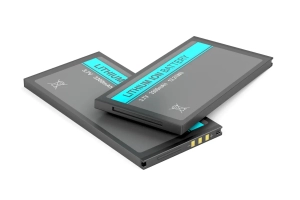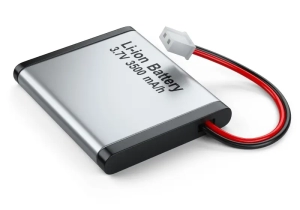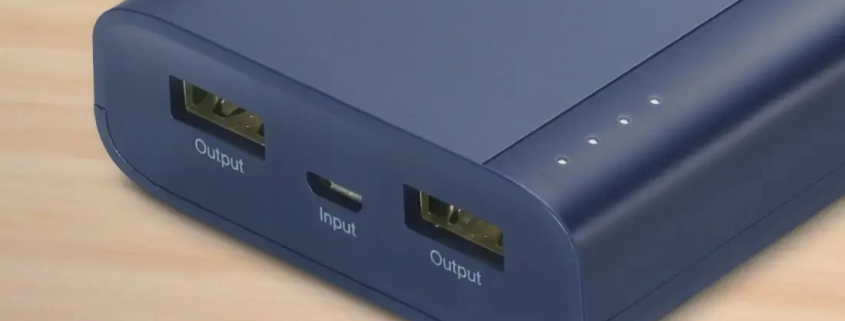Whether you’re traveling, working, or on the go, a reliable power bank ensures your smartphone, tablet, or other electronic device stays charged. But have you ever wondered what technology is inside these portable chargers? Specifically, are
banques d'alimentation powered by lithium batteries?
In this article, we’ll explore the types of batteries commonly used in power banks, focusing on lithium batteries. We’ll take a deep dive into why lithium-ion and lithium-polymer batteries are the top choices for power banks, and how these technologies shape the performance and portability of modern power storage solutions. Let’s take a look at whether power banks actually use lithium batteries, and why they’re the top choice.
What Are Lithium Batteries?
Lithium batteries are a type of rechargeable battery commonly used in many portable electronic devices, including smartphones, laptops, and power banks. They are popular due to their high energy density, long lifespan, and relatively low weight. There are two main types of lithium batteries that are often used in consumer electronics:
-
Lithium-ion (Li-ion): This is the most widely used form of lithium battery. Li-ion batteries are known for their efficiency, long charging cycles, and ability to store a large amount of energy in a small, lightweight package. They are typically used in devices that need a balance of size, weight, and performance.
-
Lithium-polymer (LiPo): Lithium-polymer batteries are similar to lithium-ion batteries but use a gel-like electrolyte instead of a liquid. This allows LiPo batteries to be even thinner and more flexible, which is why they are often used in smaller, more compact devices.
Both types of lithium batteries are favored for their high energy density, which means they can store more power in a smaller space. They also have a relatively low self-discharge rate, meaning they retain their charge longer than other battery types.
Do Power Banks Use Lithium Batteries?
Most Power Banks Use Lithium-Ion Batteries
The majority of power banks on the market today use lithium-ion batteries. These batteries are widely used in portable charging devices because of their energy density and cost-effectiveness. Lithium-ion batteries can hold a significant charge, are lightweight, and
can be recharged multiple times without significant degradation in performance. This makes them an ideal choice for power banks, which need to store enough energy to charge multiple devices without becoming bulky or heavy.
Some Power Banks Use Lithium-Polymer Batteries
In addition to lithium-ion, some power banks use lithium-polymer batteries. While these are less common, they offer certain advantages, such as being thinner and more flexible. This can be useful for creating ultra-slim power banks or devices with unique form factors. Lithium-polymer batteries are also less likely to leak or rupture, making them slightly safer than lithium-ion batteries in certain applications. However, they generally have a slightly lower energy density compared to lithium-ion batteries, which may result in a smaller battery capacity for the same size.
Why Lithium Batteries Are Preferred for Power Banks
Lithium batteries, especially lithium-ion and lithium-polymer, are the preferred choice for powering power banks due to a variety of reasons that make them the best fit for portable energy storage. Here are the main factors that contribute to their widespread use in power banks:
1. High Energy Density and Capacity
One of the primary reasons lithium batteries are favored for power banks is their high energy density. This means that lithium batteries can store a large amount of energy in a relatively small space. Power banks are designed to be portable, so having a compact battery that can store a significant amount of power is essential. Lithium-ion batteries, in particular, can provide more energy per unit of weight compared to other battery types, making them an ideal choice for lightweight, high-capacity power storage in power banks.
For example, a power bank with a lithium-ion battery can charge a smartphone multiple times before needing to be recharged itself, while keeping its own weight and size manageable for everyday use. This high energy density allows power banks to offer a substantial amount of charge in a compact form factor without becoming too bulky.
2. Rechargeability and Longevity
Lithium batteries are known for their longevity and ability to handle many charge cycles. A charge cycle refers to the process of charging a battery from 0% to 100% and discharging it back to 0%. Lithium-ion and lithium-polymer batteries can typically endure hundreds or even thousands of charge cycles before their performance starts to degrade significantly. This makes them ideal for power banks, as users need a device that can be used and recharged frequently over an extended period of time.
Unlike other battery types, such as nickel-cadmium (NiCd) or nickel-metal hydride (NiMH), which suffer from the “memory effect” and lose their capacity over time if not fully discharged, lithium batteries maintain their charge efficiency and capacity much longer. This results in better performance and a longer lifespan for power banks, reducing the need for frequent replacements.
3. Lightweight and Compact Design
Lithium batteries are significantly lighter and more compact than other rechargeable batteries. This is particularly important for power banks, which are designed to be portable and easy to carry. Power banks with lithium-ion or lithium-polymer batteries offer a combination of high energy density and low weight, making them ideal for devices that need to fit in a pocket or small bag.
Lithium batteries can store a large amount of power without significantly adding to the overall weight of the device, unlike alternatives like lead-acid batteries, which are much heavier and bulkier. This makes lithium-powered power banks highly portable, which is essential for modern lifestyles where convenience and mobility are prioritized.
4. Fast Charging Capabilities
Lithium-ion batteries can be charged relatively quickly, which is a key advantage for users who need to charge their devices in a short amount of time. Many modern power banks equipped with lithium-ion or lithium-polymer batteries also feature fast-charging technology, which allows the power bank itself to be recharged in a fraction of the time compared to older battery technologies. This is important for users who are constantly on the go and need their power bank to be ready quickly.
The fast-charging capabilities of lithium batteries also extend to the devices being charged. Power banks with lithium-ion or lithium-polymer batteries are more likely to feature USB Power Delivery (PD) or Qualcomm Quick Charge technology, enabling faster charging of smartphones, tablets, laptops, and other devices.
Are There Any Alternatives to Lithium Batteries in Power Banks?
While lithium-ion and lithium-polymer batteries dominate the power bank market, there are a few alternative battery types that have been used in portable power storage, though they are much less common:
-
Nickel-Metal Hydride (NiMH): This type of battery was once used in power banks but has largely been replaced by lithium batteries due to its lower energy density and larger size. NiMH batteries also have a higher self-discharge rate, meaning they lose charge faster when not in use.
-
Lead-Acid Batteries: Although not typically used in power banks, lead-acid batteries are still found in larger portable power stations. They are much heavier and bulkier compared to lithium batteries, which makes them impractical for smaller power banks.
Despite the availability of other battery technologies, lithium batteries remain the best option for most power banks due to their superior energy density, lightweight design, and long-lasting performance.
Conclusion
In conclusion, most power banks on the market today use lithium batteries, either lithium-ion or lithium-polymer, due to their high energy density, compact size, and efficient rechargeability. These batteries are ideal for powering portable devices, as they balance performance and portability. While alternative battery types like NiMH and lead-acid exist, they are rarely used in power banks due to their limitations in terms of size, weight, and efficiency.
As power bank technology continues to evolve, lithium batteries will likely remain the dominant power source, providing users with a reliable, efficient, and portable way to keep their devices charged on the go.
Frequently Asked Questions (FAQ)
What’s the difference between lithium-ion and lithium-polymer batteries?
The main difference between lithium-ion (Li-ion) and lithium-polymer (LiPo) batteries lies in their internal structure and the materials used for the electrolyte. Lithium-ion batteries use a liquid electrolyte, which allows them to achieve a higher energy density. This means they can store more energy in a smaller, more compact space, making them ideal for devices like power banks, where size and capacity are crucial factors. They are also more commonly used in consumer electronics.
On the other hand, lithium-polymer batteries use a gel-like electrolyte, which offers a few key advantages. They are typically thinner and more flexible than lithium-ion batteries, allowing manufacturers to create ultra-slim or uniquely shaped power banks. However, this flexibility comes with a trade-off: lithium-polymer batteries generally have slightly lower energy density than their lithium-ion counterparts, meaning they hold slightly less power in the same amount of space. Despite this, their shape and size advantages make them popular for slim power banks or devices that require a specific form factor.
While both types of batteries are rechargeable and relatively safe, lithium-ion batteries are more widely used in power banks due to their better energy efficiency, cost-effectiveness, and longer-lasting charge.
Are lithium batteries safe to use in power banks?
Lithium batteries, when used in quality power banks from reputable manufacturers, are generally safe. They are designed with multiple safety features, including protection circuits to prevent overcharging, short circuits, and overheating. Modern power banks adhere to strict safety standards, which are key to ensuring the batteries perform as expected without posing a danger. However, there are certain precautions to keep in mind to ensure safety.
Improper handling or exposure to extreme conditions can compromise the safety of lithium batteries. For instance, charging a power bank in very hot or cold environments can lead to overheating or leakage. Dropping a power bank or exposing it to punctures can damage the internal structure of the lithium battery, causing it to overheat or even catch fire in extreme cases. Additionally, counterfeit or poorly manufactured power banks may lack essential safety features, increasing the risk of malfunction. To minimize risks, always purchase power banks from trusted brands, and ensure you follow the manufacturer’s instructions for use and storage.
Can I use a non-lithium battery for a power bank?
While it is technically possible to use non-lithium batteries, such as nickel-metal hydride (NiMH) or lead-acid, in portable power banks, these battery types are not ideal for the compact, high-efficiency requirements of modern power banks. NiMH batteries have a much lower energy density compared to lithium batteries, which means they would need to be much larger and heavier to store the same amount of power. This makes them impractical for use in portable devices that need to be lightweight and easy to carry.
Lead-acid batteries, although used in larger-scale applications like backup power systems, are also unsuitable for power banks. They are much heavier and bulkier than lithium batteries, which defeats the purpose of creating a portable charging solution. Additionally, lead-acid batteries have a shorter lifespan, lower charge cycles, and are more prone to self-discharge, which makes them less efficient for use in power banks.
Lithium batteries, due to their high energy density, lightweight nature, and ability to handle numerous charge cycles without degrading, are the optimal choice for modern power banks. Their superior efficiency allows manufacturers to create smaller, lighter, and more powerful power banks, which is why they dominate the market today.
 2
2
 0
0
 4649
4649
 2
2
 0
0
 4649
4649














Laisser une réponse
Votre adresse email ne sera pas publiée. Les champs requis sont indiqués *